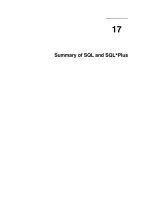Tài liệu ENCYCLOPEDIA OF HUMAN NUTRITION SECOND EDITION docx
Bạn đang xem bản rút gọn của tài liệu. Xem và tải ngay bản đầy đủ của tài liệu tại đây (3.04 MB, 170 trang )
Nutritional
Counseling
for
Lifestyle Change
1604_book.fm Page ii Tuesday, May 30, 2006 10:37 AM
CRC is an imprint of the Taylor & Francis Group,
an informa business
Boca Raton London New York
Linda Snetselaar
Nutritional
Counseling
for
Lifestyle Change
CRC Press
Taylor & Francis Group
6000 Broken Sound Parkway NW, Suite 300
Boca Raton, FL 33487-2742
© 2007 by Taylor and Francis Group, LLC
CRC Press is an imprint of Taylor & Francis Group, an Informa business
No claim to original U.S. Government works
Printed in the United States of America on acid-free paper
10 9 8 7 6 5 4 3 2 1
International Standard Book Number-10: 0-8493-1604-9 (Hardcover)
International Standard Book Number-13: 978-0-8493-1604-3 (Hardcover)
Library of Congress Card Number 2006044026
This book contains information obtained from authentic and highly regarded sources. Reprinted
material is quoted with permission, and sources are indicated. A wide variety of references are
listed. Reasonable efforts have been made to publish reliable data and information, but the author
and the publisher cannot assume responsibility for the validity of all materials or for the conse-
quences of their use.
No part of this book may be reprinted, reproduced, transmitted, or utilized in any form by any
electronic, mechanical, or other means, now known or hereafter invented, including photocopying,
microfilming, and recording, or in any information storage or retrieval system, without written
permission from the publishers.
For permission to photocopy or use material electronically from this work, please access www.
copyright.com ( or contact the Copyright Clearance Center, Inc. (CCC)
222 Rosewood Drive, Danvers, MA 01923, 978-750-8400. CCC is a not-for-profit organization that
provides licenses and registration for a variety of users. For organizations that have been granted a
photocopy license by the CCC, a separate system of payment has been arranged.
Trademark Notice: Product or corporate names may be trademarks or registered trademarks, and
are used only for identification and explanation without intent to infringe.
Library of Congress Cataloging-in-Publication Data
Snetselaar, Linda G.
Nutrition counseling for lifestyle change / Linda Snetselaar.
p. cm.
Includes bibliographical references and index.
ISBN 0-8493-1604-9 (alk. paper)
1. Nutrition counseling. 2. Health counseling. 3. Obesity Psychological
aspects. I. Title.
RC628S642 2006
616.3’9806 dc22 2006044026
Visit the Taylor & Francis Web site at
and the CRC Press Web site at
1604_Discl.indd 1 6/6/06 1:24:20 PM
v
PREFACE
This book is a combination of experiences in which I have been involved
over my professional career. It brings a combination of ideas together
that include methods of communicating, strategies for behavior change,
ways to assess problems, and methods to facilitate self-management. The
concepts presented in this book have been tested in a variety of clinical
trials where lifestyle change was needed to determine if dietary change
affected disease.
The goal of lifestyle change as presented here is to maximize the
patients’ abilities to tailor a strategy to their current situation and make a
major and lasting change that improves health over time. Sections in this
book present ways to facilitate change in different age groups based on
clinical trial work.
Examples of dialogues that occur with specific age groups of patients
illustrate what might actually happen as counseling for change occurs.
Innovative ways of communicating are presented with new strategies for
facilitating the patients’ ways of dealing with stress as eating habits change.
In general, this is a text for the practitioner and student who strive to
help the patient change in a tailored fashion that potentially assures success
relative to maintenance.
1604_book.fm Page v Tuesday, May 30, 2006 10:37 AM
1604_book.fm Page vi Tuesday, May 30, 2006 10:37 AM
vii
THE AUTHOR
Linda G. Snetselaar
is currently a professor in the Department of Epi-
demiology, College of Public Health at the University of Iowa. She is an
endowed Chair of Preventive Nutrition Education. Her work has been in
the area of multi-center randomized clinical trials mostly funded by the
National Institutes of Health and emphasizing dietary change over long
periods of time. She has focused on how to change and maintain eating
behaviors with a focus on affecting dietary habits in individuals throughout
the United States.
Dr. Snetselaar has been a director of many workshops on the topic of
dietary change using an eclectic behaviorally based approach. She has
worked to change eating behaviors in a variety of research projects: The
Lipid Research Clinics Study, The Diabetes Control and Complications
Trial, The Modification of Diet in Renal Disease Study, The Diet Interven-
tion Study in Children, The Diet Intervention Study in Children 2006, The
Women’s Intervention Nutrition Study, and the Women’s Health Initiative.
She has also provided expertise to wellness programs for large industries.
She is currently focused on translating much of what was learned in these
long-term trials to routine care in clinics in the United States.
Dr. Snetselaar teaches master’s, doctoral, and medical students in the
Colleges of Public Health and Medicine at the University of Iowa. She
enjoys facilitating the learning process and being a mentor to students.
Dr. Snetselaar is chair of her college’s Faculty Council and serves on the
University Faculty Senate and Council.
1604_book.fm Page vii Tuesday, May 30, 2006 10:37 AM
1604_book.fm Page viii Tuesday, May 30, 2006 10:37 AM
ix
CONTENTS
1
Introduction 1
1.1 The Mediterranean Diet and Its Past Influences 1
1.2 Mediterranean Populations and Their Changing Dietary Patterns 4
1.3 American Changes in Dietary Patterns and Origins 4
1.4 Conclusion 9
References 15
2
Assessment of Life Cycle Factors Related to Diet and
Obesity-Associated Disease 17
2.1 Prevention in Childhood: Stage 1 17
2.1.1 Eating Habits of Children and Adolescents in Relation
to the Dietary Guidelines 18
2.1.2 Fostering Patterns of Preference Consistent with Healthier
Diets in the Very Young 18
2.1.3 Parental Influences on Children’s Food Preferences and
Patterns 19
2.1.3.1 Availability of Foods 19
2.1.3.2 Types of Child Feeding Practices 20
2.1.3.3 Parental Modeling of Eating Behavior 21
2.1.4 Parental Eating Habits Mirror Those in Their Young
Children 21
2.1.5 Existing Family-Based Interventions 22
2.2 Remediation in Children and Adolescents: Stage 2 23
2.2.1 Family-Based Interventions in Older Children 23
2.3 Remediation in Adults: Stage 3 24
References 26
3
Predictors of Maintained Behavior Change with
Emphasis on Weight Loss 33
3.1 Extended Treatment 33
3.2 Skills Training 34
3.3 Food Provision 35
1604_book.fm Page ix Tuesday, May 30, 2006 10:37 AM
x
Ⅲ
Nutrition Counseling for Lifestyle Change
3.4 Monetary Incentives 37
3.5 Telephone Prompts and Counseling 37
3.6 Peer Support 37
3.7 Exercise 38
3.8 Multicomponent Maintenance Programs 39
References 41
4
Lifestyle Change Factors Related to Lifecycle Stages 1,
2, and 3 45
4.1 Stage 1: Childhood and Parental Feeding Habits 45
4.1.1 Educational Dietary Intervention Aspects 46
4.1.1.1 Overview 46
4.1.1.2 Core Elements 46
4.1.1.3 Theoretical Model 46
4.1.2 Behavioral Change Aspects 47
4.1.2.1 Overview 47
4.1.2.2 Core Elements 47
4.1.2.3 Theoretical Model 48
4.1.3 Strategies Used to Change Parent/Child Feeding
Practices — Contrasting Educational and Behavioral
Change Aspects 49
4.1.4 Intervention Development 49
4.2 Stage 2: Remediation in Childhood and Adolescence 49
4.3 Stage 3: Remediation in Adults and the Elderly 52
References 53
5
Motivational Interviewing for Childhood and Parental
Feeding Habits: Stage 1 55
5.1 Parental Infant Feeding Practices Associated with Food
Preferences 55
5.2 Evaluating a Child’s Eating Habits 56
5.3 Not-Ready-to-Change Counseling Session 57
5.4 Unsure-about-Change Counseling Sessions 61
5.5 Ready-to-Change Counseling Sessions 62
5.6 Summary 63
References 63
6
Motivational Interviewing for Children and Adolescents:
Stage 2 67
6.1 Changing Dietary Habits in Adolescents 67
6.2 Not-Ready-to-Change Counseling Session 69
6.3 Unsure-about-Change Counseling Sessions 72
6.4 Ready-to-Change Counseling Sessions 73
References 74
7
Motivational Interviewing for Adults and the Elderly:
Stage 3 77
7.1 Intervention Phase 1 (Not Ready to Change) 80
1604_book.fm Page x Tuesday, May 30, 2006 10:37 AM
Contents
Ⅲ
xi
7.2 Intervention Phase 2 (Unsure about Change) 81
7.3 Intervention Phase 3 (Ready to Change) 81
7.4 Summary 82
References 83
8
Innovative Approaches to Maintaining Healthy
Behaviors 85
References 88
9
Tailoring to Patient Needs 91
9.1 Identifying Your Patient 91
9.1.1 Gender 91
9.1.2 Age 92
9.1.3 Ethnicity 93
9.2 Identifying Your Patient’s Desires 103
9.3 Identifying Your Patient’s Needs 104
9.4 Tailoring Strategies 104
9.5 Tailoring Messages 104
9.6 Using Tailoring in Group Settings 105
References 105
10
Examples of Dietary Strategies Based on Long-Term
Randomized Clinical Trials Focused on Lifestyle
Change 107
10.1 Knowledge and Skills Strategies 108
10.2 Feedback 109
10.3 Modeling 110
10.4 Support and Patient-Centered Counseling 111
10.4.1 Self-Management 111
10.4.2 Self-Monitoring 111
References 113
11
Reducing Stress to Maintain Dietary Change 115
11.1 Definition of Stress 115
11.2 Identifying Stress 115
11.3 Strategies to Reduce Stress 117
11.4 Two Approaches and Orientations 118
11.4.1 Positive Self-Talk 119
11.4.2 Planning Ahead 120
11.4.3 Time-Management Skills 120
11.4.4 Support Systems 122
11.4.5 Feasible Goals 122
11.4.6 Assertiveness 122
References 122
12
Organizing Data on Dietary Change 123
12.1 Setting the Stage for Organization 123
12.2 Presenting Dietary Adherence Data to Patients 126
1604_book.fm Page xi Tuesday, May 30, 2006 10:37 AM
xii
Ⅲ
Nutrition Counseling for Lifestyle Change
12.3 Involving the Patient in Lifestyle Change Data Review 126
13
Potential New Theories Playing a Role in Nutrition
Lifestyle Change 129
13.1 Affective and Cognitive Factors Influence Weight Control
Behaviors 129
13.2 Negative Affective States and Dysfunctional Cognitions Related
to Relapse 130
13.3 The Counselor-Patient Interaction 133
References 133
14
Summary 137
Appendix A
What Your Baby Can Do and How and What to Feed
Him 139
Appendix B
Parental Feeding Practices Intervention Session #1 —
Overheads 143
Session #1: Intervention Group Overheads 143
Feeding with a Division of Responsibility 143
Appendix C
Parental Feeding Practices Intervention Session #2 —
Handouts 145
Session #2: Intervention Group Handouts 145
Feeding Your Baby Fruits and Vegetables 145
Feeding Your Baby Fruits and Vegetables 146
Divisions of Responsibility 146
Feeding Behavior Worksheet 147
Parental Modeling 147
Food Environment 147
Feeding Practices 147
Index 149
1604_book.fm Page xii Tuesday, May 30, 2006 10:37 AM
1
1
INTRODUCTION
The concept of nutrition lifestyle change as it is described in this text
includes not only eating habits but the environmental factors that surround
them. Lifestyle change for improved eating patterns is complex. Changes
in eating habits require a knowledge of eating patterns and discovery of
the role past history played in shaping the way we eat. Additionally,
lifestyle change must be based upon behavioral theories as they relate to
dietary habit modification. An in-depth awareness of the importance of
foods, their nutrient composition, and methods of food preparation should
be a focus. Along with emphasis on diet is the immense importance of
daily activity and planned exercise. It is beyond the focus of this text to
describe specifics related to activity and exercise, but that does not
diminish their immense importance in the process of lifestyle change.
Equally important is our desire to minimize stress in our lives as lifestyle
change occurs. This important concept will be dealt with in discussions
related to eating and food preparation.
1.1 THE MEDITERRANEAN DIET AND ITS
PAST INFLUENCES
In our American culture we have adopted a love for many ethnic dishes.
One of those is the food and beverage characteristics of the Mediterranean
diet. This eating pattern is of importance in this book because it includes
many topics related to those discussed in the paragraph above. Nestle
indicates that the Mediterranean diet is of value as a model of a dietary
pattern that results in one of the lowest incidence rates of chronic diseases
and highest life expectancies compared to other regions in the world
[1–5]. Table 1.1 and Table 1.2 show comparisons of Italian and U.S. life
expectancy data.
1604_C001.fm Page 1 Tuesday, June 20, 2006 9:38 AM
2
Ⅲ
Nutrition Counseling for Lifestyle Change
We learn from a study of the Mediterranean diet that not only are
specific foods and beverages important, but a lifestyle of physical activity
and attention to reduced stress is also paramount. Love of food in the
Mediterranean culture means preparing and eating food in a slow and
relaxed fashion. The focus is on enjoying the process of food preparation
and then eating slowly to experience flavors, textures, aromas, and colors
in each dish.
The Mediterranean diet has an ancient history that provides reasons
for the specific foods enjoyed in this eating pattern. To understand why
this population living in certain regions bordering the Mediterranean Sea
eat in a specific way, we must look back to past centuries and their
influence on eating habits.
Evidence of ancient diets in the regions bordering the Mediterranean Sea
are in abundance [6]. Nestle indicates the problems in evaluating evidence
from a variety of sources. The problems include translating, classifying,
dating, and interpreting information. In spite of these difficulties, researchers
have documented plant and animal, bread, spices, sweets, beer, and wine
from ancient cultures [6–9]. It should be noted that the presence of foods
in a region is an association and not firm proof of its usual consumption.
Writers of the classics speak of the foods eaten by warriors and noblemen.
Table 1.1 Life Expectancy Early 1990s — Italy and
the U.S.
a
Italy U.S.
Women 80.5 79.2
Men 73.7 72.2
a
Australian Institute of Health and Welfare Australia’s
Health 1996. Canberra. Australian Government Print-
ing Service; 1996.
Table 1.2 Life Expectancy Today — Italy and
the U.S.
Italy U.S.
Women 82.0 79.4
Men 75.8 73.9
Note
: Annuario statisticl italiano–2000. Rome, ISTAT,
2001. OECD health data 2000: a comparative analysis
of 29 countries. Paris: Organization for Economic Co-
operation and Development, 2000. .
gov/nchs/data/hus/tables/2003/03hus027.pdf.
1604_C001.fm Page 2 Tuesday, June 20, 2006 9:38 AM
Introduction
Ⅲ
3
Researchers who have carefully analyzed Homer’s writings note that the
food of this elite group of people included mostly meat, bread, and wine
[9]. The common people consumed a diet based on plant foods and bread,
with seafood eaten only occasionally. Olive oil was also abundant [9].
From the second to third century, in classical texts, poets describe
foods in terms of their flavors, aromas, preparation methods, and their
role in everyday meals and elaborate banquets. This might indicate that
the Mediterranean diet of the time was consumed by all classes of the
Mediterranean populace [10].
Montanari describes two opposing cultures: one based on bread, wine,
and oil and the other on meat, milk, and butter [11]. Archaeological studies
of human remains found in medieval sites indicate a very balanced diet.
The reality in medieval times was that when famine occurred because of
drought, other sources of food — lamb, fish, beef, and sheep’s milk helped
assure adequate nutritional intakes [12]. Montanari presents the differences
between peasants and noblemen [13]. Peasants almost always boiled meat
dishes. Noblemen roasted meat on long skewers on wide grills. For the
warring nobles, roasted meat symbolized a link between the notions of
meat eating and physical strength. Montanari summarizes that there was
an “inevitable equation between strength and power, and an equal link
between meat and power” [13].
Although meat was emphasized in the early cultures of the Middle
Ages, the Mediterranean diet researched in the Rockefeller Foundation
Studies in the early 1950s showed a diet that was near vegetarian [14].
This near-vegetarian diet contained specific nutrient and non-nutrient
components, antioxidant vitamins, fiber, and a variety of phenolic com-
pounds [15–17]. Investigators in this study conducted 7-day weighed food
inventories on 128 households, and 7-day dietary intake records were
obtained on 7500 persons in those households. A food frequency ques-
tionnaire was administered to 765 households.
An additional study conducted by the European Atomic Energy Com-
mission (EURATOM) compared nine regions in northern Europe and two
in southern Europe (both in southern Italy) [15]. Investigators in this study
conducted 7 consecutive days of dietary interviews on 3725 families and
weighed all foods present in the households on those 7 days. The study
showed that although there were no consistent north-south variations in
overall intake of table fat, the foods that contributed fat to the diets in
the two regions were different. In the northern regions butter and mar-
garine were consumed in larger quantities. In the southern two regions
margarine was not consumed at all and the principal fat was olive oil.
Additionally, in the southern regions, greater amounts of cereals, vegeta-
bles, fruit, and fish were eaten with smaller intakes of potatoes, meat,
dairy foods, eggs, and sweets described.
1604_C001.fm Page 3 Tuesday, June 20, 2006 9:38 AM
4
Ⅲ
Nutrition Counseling for Lifestyle Change
1.2 MEDITERRANEAN POPULATIONS AND THEIR
CHANGING DIETARY PATTERNS
Although these studies in the 1960s indicate very healthy eating habits,
studies today in Crete, where investigators used 24-hour recall data with
biomarkers to assess intakes, showed a decrease in bread, fruit, potatoes,
and olive oil with increases in meat, fish, and cheese [19]. These data
were compared to that collected by Kromhout and his colleagues in the
1960s [20]. Italian cuisine has also followed this same path [21]. Food
balance data collected in this region since the 1960s indicate that the
availability of meat, dairy products, and animal fats has increased [22, 23].
A more recent study by Trichopoulou and his colleagues in Crete
shows that greater adherence to the traditional Mediterranean diet results
in significant decreases in overall mortality [24]. For death due to coronary
heart disease and cancer, an inverse association was found in the group
of persons who adhered to the diet. It is interesting to note that associ-
ations between individual food groups and total mortality did not show
statistical significance.
1.3 AMERICAN CHANGES IN DIETARY PATTERNS
AND ORIGINS
The Mediterranean diet has very distinct origins. Many healthy eating
habits in the 1960s were a carryover from ancient times. Just as the
Mediterranean diet is changing today in comparison to the 1960s, the
American diet is also undergoing alterations.
Greg Critser in his book,
Fat Land
, chronicles the increase in obesity
in America by describing political and food industry roles in changing the
type and amount of food we eat [25]. He begins by describing the
agricultural secretary’s push to enlarge the farmer’s marketplace and
increase corn production. By the mid-1970s its production was at an all-
time high leading to an equivalent increase in farmers’ income. Critser
describes these corn surpluses as a spur to those makers of convenience
foods who now focused on new-product development and sales.
In 1971 Japanese scientists developed a cheaper sweetener called high-
fructose corn syrup, HFCS [26]. Compared to cane sugar, it was six times
sweeter, and because it was a corn product, the cost of production was
drastically reduced. Also, its preservation properties, such as preventing
freezer burn and increasing shelf-life of products made it a sought-out item.
In addition to its properties of sweetness and stability there are other
characteristics of HFCS that affect our physiology. Compared to sucrose,
fructose bypasses many critical intermediary paths and goes directly to
the liver, where it is used as a building block for triglycerides. It then
1604_C001.fm Page 4 Tuesday, June 20, 2006 9:38 AM
Introduction
Ⅲ
5
causes an increase in fatty acids in the blood. When muscle tissue is
exposed to excessive levels of fatty acids, the result is a resistance to
insulin that leads to type 2 diabetes [27, 28].
At the University of Minnesota, John Bantle, who has worked in a
variety of National Institutes of Health studies, including the Diabetes
Control and Complications Trial, used a clinical trial study design with two
dozen healthy volunteers who consumed a diet containing 17% of their
calories from fructose. Secondly, those same subjects were switched to a
diet sweetened mainly with sucrose. The results of the study showed that
the fructose diet produced significantly higher triglycerides than the
sucrose-sweetened diet [29]. Hollenbeck further points to the negative
aspects of fructose by concluding that the harmful effects of fructose appear
to be greater for those at an increased coronary heart disease risk [30].
McCrory and his colleagues provide the data in Figure 1.1 and Figure
1.2 to show the connection between fructose-laden foods and BMI [31].
In the mid-1970s palm oil became the focus as a fat source similar
to HFCS for sugar. Just as HFCS had very positive sweetening properties,
palm oil also provided stabilizing properties to allow products to last for
long periods of time on the supermarket shelves [32]. Because palm oil
was from a vegetable source, few saw its highly saturated characteristics
as a potential medical problem. Because of regulations around foods, their
Figure 1.1 The associations between body fatness and dietary variety obtained
from vegetables (A) and sweets, snacks, condiments, entrées, and carbohydrates
(B). Partial correlations are shown, meaning that each relation is adjusted for age,
sex, and dietary variety in the other food group. With the effects of age and sex
controlled for in multiple regression analysis on percentage body fat, the variety
of vegetables consumed was inversely associated with body fatness, and the
variety of sweets, snacks, condiments, entrées, and carbohydrates consumed was
positively associated with body fatness (overall R2 = 0.46, P < 0.0001) [31].
55
45
35
25
15
5
110
100
90
80
70
60
50
40
30
20
120
Variety (% of total), adjusted
Body fat (% of wt), adjusted
Partial r = –0.31
P = 0.008
A
55
45
35
25
15
5
90807060504030 100
Variety (% of total), adjusted
Partial r = 0.38
P = 0.001
B
1604_C001.fm Page 5 Tuesday, June 20, 2006 9:38 AM
6
Ⅲ
Nutrition Counseling for Lifestyle Change
long-term medical implications were not considered as important as imme-
diate purity and ability to stabilize food products where a long shelf life
was needed.
In addition to the insertion of HFCS and palm oil into our food
economy, fast-food chains in the 1970s played a role in increasing the
amount of foods Americans eat. Greg Critser describes the super-sizing
phenomenon and how it became popular [33]. He attributes the increase
in super-sizing to fast food companies’ designs on increasing per product
margin. The concept is that the super-sized product is one costing the
company only a small amount. To super-size this type of item means that
more customers spend just a little more but feel that they have purchased
more for the money. This marketing strategy led to increased sales and
repeat purchases. It allowed the American public to eat more without
purchasing double items, resulting in feelings of gluttony.
The USDA graphically depicts the changes in our American culture
that over time have contributed to increases in caloric consumption
( Figure 1.3 shows exam-
ples of portioning changes over time.
Critser provides a variety of reasons for why American caloric intake
is out of control. He focuses first on the fact that two catalysts were
responsible for what he terms “boundary-free” eating in American culture.
One is individual freedom where women in the 1960s and 1970s made
Figure 1.2 Associations between body fatness and the variety ratio, calculated
as the ratio of the variety of vegetables to the variety of sweets, snacks, condi-
ments, entrées, and carbohydrates (adjusted for age, sex, and percentage dietary
fat), and percentage dietary fat (adjusted for age, sex, and the variety ratio).
When the variety ratio and dietary fat were included in the same regression
model, dietary fat was not significantly associated with body fatness (R2 = 0.44,
P < 0.0001) [31].
60
50
40
30
20
10
0
2.01.51.00.50.0 2.5
Variety ratio, adjusted
Body fat (% of wt), adjusted
Partial r = –0.27
P = 0.02
60
50
40
30
20
10
0
5040302010 60
Dietary fat (% of energy), adjusted
Partial r = 0.13
P = 0.28
1604_C001.fm Page 6 Tuesday, June 20, 2006 9:38 AM
Introduction
Ⅲ
7
Figure 1.3 Examples of portioning changes over time. See .
tmc.edu/pa/portiondist.htm.
Do you suffer ‘Portion Distortion’?
If you think food portions are bigger than they used to be, you’re right. Take a look at how
“typical” restaurant portion sizes have grown over the past 20 years or so:
Portion Size
Food
Was Now
Soda
6 ounces
(85 calories)
20 ounces
(300 calories)
Bagel
3-inch diameter
(140 calories)
5 to 6 inches
(350 calories or more)
Chips
1 oz. bag
(150 calories)
1.75 oz. “Grab Bag”
(about 260 calories)
Pasta
2 cups
(280 calories without
sauce or fat)
4 cups or more
(560 calories or more without
sauce or fat)
Burger
2 oz. patty + bun
(270 calories)
4 oz. patty + bun
(430 calories)
French Fries
2 ounces
(210 calories)
5 ounces
(540 calories)
Dinner Plate
10-inch diameter 12-1/2 inch diameter
Developed by the Children's Nutrition Research Center
Before blaming your local restaurateur for your family’s growing waistlines, take an honest look at
how you “value” dining out experiences. According to the National Restaurant Association’s
Dinner Decision Making study, most consumers rank portion size as one of the 10 “hallmarks of a
great place.”
1604_C001.fm Page 7 Tuesday, June 20, 2006 9:38 AM
8
Ⅲ
Nutrition Counseling for Lifestyle Change
up a large portion of the workforce. This change modified the traditional
family table of the 1950s in the evenings. It now became more advanta-
geous to eat out or order in, often not eating around a dinner table. Table
1.3 and Table 1.4 show that this change in culture was reflected in the
consumption statistics of Americans. Figure 1.4 illustrates changes in daily
caloric consumption in the U.S., 1910–2000.
To provide the general public with easy-to-understand concepts about
healthy eating, the USDA created the Food Guide Pyramid. Figure 1.5 has
a comparison of the current USDA Food Guide Pyramid and the Mediter-
ranean Food Guide Pyramid. Also shown in that figure are two other
emerging pyramids focused on food groups: The Harvard Medical School
Table 1.3 Changes over Time in Foods Eaten
Away from Home
Year
Percent of the Food
Dollar Eaten Away From
Home
1970 25
1985 35
1996 40
Source:
Lin, B.H., Guthrie, J., Frazao, E., Nutrient con-
tribution of foods eaten away from home, in
Amer-
ica’s Eating Habits: Changes and Consequences
,
Frazao, E., Ed., Agriculture Information Bulletin 750,
USDA, Washington, DC, 1999, 213.
Table 1.4
Year
Snacks Consumed
Away from
Home (%)
Proportion of Meals
Consumed Away
from Home (%)
1977 17 16
1987 20 24
1995 22 29
Source:
Lin, B.H., Guthrie, J., Frazao, E., Nutrient
contribution of foods eaten away from home, in
America’s Eating Habits: Changes and Conse-
quences
, Frazao, E., Ed., Agriculture Information
Bulletin 750, USDA, Washington, DC, 1999, 213.
1604_C001.fm Page 8 Tuesday, June 20, 2006 9:38 AM
Introduction
Ⅲ
9
Guide to Healthy Eating and the Prader-Willi Syndrome Food Pyramid.
Each pyramid has a different food group focus
.
1.4 CONCLUSION
The concept of lifestyle change requires that we understand first where
we are in terms of eating styles (American food habits) and where we
might go in terms of dietary pattern (Mediterranean diet and lifestyle).
This book focuses on lifestyle change and how that might be accomplished
in an American culture dictated by time and efficiency. Strategies for
change presented in this text were and are used in a variety of randomized
controlled clinical trials where lifestyle change for extended periods of
time must be maintained. Additional research on maintenance of lifestyle
change is currently being studied in randomized controlled clinical trials.
These trials will provide evidence of methods to help maintain lifestyle
change. Examples of some of these as-yet-unstudied maintenance strate-
gies are described in the chapters that follow.
The purpose of this text is to expose students with an interest in dietary
and lifestyle change to an understanding of methods related to achieving
that change. Examples of problem situations and diet change strategies
will be included.
Figure 1.4 Daily calorie consumption in the U.S., 1910–2000. (Source: Putnam,
J., Alishouse, J., and Kantor, L. S. 2002. U.S. per capita food supply trends: more
calories, refined carbohydrates, and fats.
Food Review
25(3):2–15.)
4,000
3,500
3,000
2,500
2,000
Calories per person per day
Total food supply available for consumption
Food supply adjusted for
spoilage, cooking losses,
plate waste, and other losses
199019801970196019501940193019201910 2000
1604_C001.fm Page 9 Tuesday, June 20, 2006 9:38 AM
10
Ⅲ
Nutrition Counseling for Lifestyle Change
Figure 1.5 Comparison of the current USDA Food Guide Pyramid and the Med-
iterranean Food Guide Pyramid. Also shown are two other emerging pyramids
focused on food groups: The Harvard Medical School Guide to Healthy Eating
and the Prader-Willi Syndrome Food Pyramid. Each pyramid has a different food
group focus
.
U.S.D.A. Food Guide Pyramid
/>Provides nutritional guidelines for Americans
Emphasizes consumption of grain products, fruits, and vegetables
____________________________________________________
Harvard School of Public Health “Healthy Eating” Pyramid
/>Emphasizes a mostly plant-based diet, including unsaturated oils
Discourages consumption of red meat and refined carbohydrates
Includes guidelines for exercise, weight control, alcohol intake, and supplement use
1604_C001.fm Page 10 Tuesday, June 20, 2006 9:38 AM
Introduction
Ⅲ
11
Figure 1.5
Continued.
Vegetarian Diet Pyramid
Provides nutritional guidelines for
persons following a vegetarian diet
Emphasizes whole grains, fruits,
vegetables, and legumes
Includes alternatives to dairy
products
Discourages frequent egg
consumption
/>ml
Traditional Latin-American Diet
Pyramid
Emphasizes foods specific to the
traditional diets of Latin America
Discourages egg and red meat
consumption
Includes dairy, poultry, fish, and shellfish
as protein sources
/>n.html
1604_C001.fm Page 11 Tuesday, June 20, 2006 9:38 AM
12
Ⅲ
Nutrition Counseling for Lifestyle Change
Figure 1.5
Continued.
Traditional Mediterranean Diet
Pyramid
Emphasizes consumption of
starchy foods
Includes foods common to
traditional Mediterranean diets
Discourages red meat
consumption
Recommends fish, yogurt, and
cheese as primary protein
sources
/>p_med.html
Traditional Asian Diet Pyramid
Includes foods and beverages
popular within traditional Asian diets
Emphasizes consumption of grain
products
Recommends fish, shellfish, and
dairy as main protein sources
/>asian.html
1604_C001.fm Page 12 Tuesday, June 20, 2006 9:38 AM









